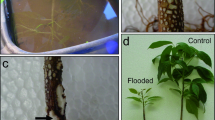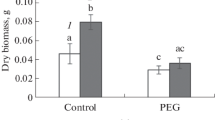Abstract
The costs of adaptation respiration, the contribution of different biochemical pathways of respiration and alternative oxidases to the adaptation to mineral deficiency were compared in plant species representing different types of adaptive strategies: ruderal (Ru) (Amaranthus retroflexus L. and Leonurus quinquelobatus Gilib.) and predominantly stress-tolerant type (St) (Dactylis glomerata L. and Medicago sativa L.). The adaptation component of the total dark respiration was calculated on the basis of the relative growth rate and the ratio of dark respiration to gross photosynthesis. Adaptation costs were greater in less tolerant species. The inhibitory analysis showed that the contribution of glycolytic pathway decreased and the proportion of oxidative pentose phosphate pathway and residual respiration increased in the intolerant Ru-species under the conditions of abiotic stress. Conversely, in the tolerant St-species, the contribution of glycolysis increased. In all species studied, the contribution of the cytochrome pathway of substrate oxidation was reduced and the contribution of the alternative cyanide-insensitive and residual respiration increased under conditions of mineral deficiency; this phenomenon was particularly pronounced in a less tolerant species L. quinquelobatus. In the species characterized by Ru-strategy, stress increased the content of phenolic compounds and shikimic acid. We suppose that the adaptation respiration costs are associated with alternative biochemical pathways and alternative cyanide-resistant oxidase. The role of these pathways in the plants with St-strategy consists in maintaining the active state of oxidative pathways, whereas in the plants with Ru-strategy, they serve to burn excess metabolites and enhance the synthesis of secondary metabolites, which perform protective functions.
Similar content being viewed by others
REFERENCES
Golovko, T.K., Dykhanie rastenii. Fiziologicheskie aspekty (Plant Respiration: Physiological Aspects), St. Petersburg: Nauka, 1991.
Moldau, Kh.A., Syber, Ya.K., and Rakhi, M.O., The Components of Dark Respiration in Kindey Bean Plants at Water Deficiency, Fiziol. Rast. (Moscow), 1980, vol. 27, pp. 5-10 (Sov. Plant Physiol., Engl. Transl.).
Semikhatova, O.A., Evaluation of Plant Adaptation Potential by Assessing Dark Respiration, Fiziol. Rast. (Moscow), 1998, vol. 45, pp. 142-148 (Russ. J. Plant Physiol., Engl. Transl.).
Lambers, H., Posthumus, F., Stulen, I., Lanting, L., van de Dijk, S.J., and Hofstra, R., Energy Metabolism of Potato major ssp. major as Dependent on the Supply of Mineral Nutrients, Physiol. Plant., 1981, vol. 51, pp. 241-252.
Ribas-Carbo, M., Aroca, R., and Gonzales-Meler, M.A., The Electron Partitioning between the Cytochrome and Alternative Respiratory Pathways during Chilling Recovery in Two Cultivars of Maize Differing in Chilling Sensitivity, Plant Physiol., 2000, vol. 122, pp. 199-204.
Wagner, A.M. and Moore, A.L., Structure and Function of the Plant Alternative Oxidase: Its Role in the Oxygen Defence Mechanism, BioSci. Rep., 1997, vol. 17, pp. 319-333.
Millenaar, F.F., Benschop, J.J., Wagner, A.M., and Lambers, H., The Role of the Alternative Oxidase in Stabilizing the in vivo Reduction State of the Ubiquinone Pool and the Activation State of the Alternative Oxidase, Plant Physiol., 1998, vol. 118, pp. 599-607.
Sluse, F.E., Almeida, A.M., Jarmuszkiewicz, W., and Vercesi, A.E., Free Fatty Acids Regulate the Uncoupling Protein and Alternative Oxidase Activities in Plant Mitochondria, FEBS Lett., 1998, vol. 433, pp. 237-240.
Shugaev, A.G., Alternative Cyanide-Resistant Oxidase in Plant Mitochondria: Structure, Regulation of Activity, and Presumable Physiological Role, Fiziol. Rast. (Moscow), 1999, vol. 46, pp. 307-320 (Russ. J. Plant Physiol., Engl. Transl.).
Wagner, A.M. and Krab, K., The Alternative Respiratory Pathway in Plants: Role and Regulation, Physiol. Plant., 1995, vol. 95, pp. 318-325.
Azcon-Bieto, J., Lambers, H., and Day, D.A., Effect of Photosynthesis and Carbohydrate Status on Respiratory Rates and the Involvement of the Alternative Pathway in Leaf Respiration, Plant Physiol., 1983, vol. 72, pp. 598-603.
Lambers, H., Respiration in Intact Plants and Tissues: Its Regulation and Dependence on Environmental Factors, Metabolism and Invaded Organisms, Encycl. Plant Physiol. New Ser., vol. 18, Higher Plant Cell Respiration, Douce, R. and Day, D.A., Eds., Berlin: Springer-Verlag, 1985, pp. 418-473.
Shugaev, A.G. and Sokolova, S.V., The Changes in the Pathways of Mitochondrial Oxidation at the Initial Period of Tuber Development, Fiziol. Rast. (Moscow), 2001, vol. 48, pp. 55-61 (Russ. J. Plant Physiol., Engl. Transl.).
Nosov, A.M., Functions of Plant Secondary Metabolism in vivo and in vitro, Fiziol. Rast. (Moscow), 1994, vol. 41, pp. 873-878 (Russ. J. Plant Physiol., Engl. Transl.).
Matern, U., Coumarins and Other Phenylpropanoid Compounds in the Defense Response of Plant Cells, Planta Med., 1991, vol. 57, no. 7, p. 515.
Kutchman, T.M., Ecological Arsenal and Developmental Dispatcher: The Paradigm of Secondary Metabolism, Plant Physiol., 2001, vol. 125, pp. 58-60.
Herms, D.A. and Mattson, W.J., The Dilemma of Plants: To Grows or Defend, Q. Rev. Biol., 1992, vol. 67, pp. 283-335.
Grime, G.P., Hongson, J.G., and Hunt, R., Comparative Plant Ecology, London: Unwin Human, 1988.
Mirkin, B.M., Usmanov, I.Yu., and Naumova, L.G., Types of Plant Strategy: The Position in the Systems of Species Classification and Trends in Development, Zh. Obshch. Biol., 1999, vol. 60, pp. 581-595.
P'yankov, V.I. and Ivanov, L.A., The Biomass Structure of Plants with Different Types of Ecological Strategy in Boreal Zone, Ekologiya (Yekaterinburg), 2000, no. 1, pp. 3-10.
Rakhmankulova, Z.F. and Usmanov, I.Yu., Morphological and Physiological Characteristics of Wheat Cultivars Differing in Resistance and Productivity under Normal and Stress Conditions, Fiziol. Rast. (Moscow), 2000, vol. 47, pp. 608-613 (Russ. J. Plant Physiol., Engl. Transl.).
P'yankov, V.I., Ivanov, L.A., and Lambers, Kh., Plant Construction Cost in the Boreal Species Differing in Their Ecological Strategies, Fiziol. Rast. (Moscow), 2001, vol. 48, pp. 81-88 (Russ. J. Plant Physiol., Engl. Transl.).
Rakhmankulova, Z.F., Ramazanova, G.A., and Usmanov, I.Yu., Growth and Respiration in Plants from Various Adaptation Group as Affected by Mineral Nutrient Deficiency, Fiziol. Rast. (Moscow), 2001, vol. 48, pp. 75-80 (Russ. J. Plant Physiol., Engl. Transl.).
Rabotnov, T.A., On the Types of Plant Strategy, Ekologiya (Sverdlovsk), 1985, no. 3, pp. 3-11.
Gavrilenko, V.F., Ladygina, M.E., and Khandobina, L.M., Bol'shoi praktikum po fiziologii rastenii (Manual of Plant Physiology), Moscow: Vysshaya Shkola, 1975.
Golovko, T.K., Quantitative Interrelations between Photosynthesis and Respiration in Grasses, Bot. Zh. (Leningrad), 1983, vol. 68, pp. 779-788.
Rakhmankulova, Z.F., Ramazanova, G.A., Mustafi-na, A.R., and Usmanov, I.Yu., Assessment of Respiratory Costs of Adaptation in Plant Species That Differ in Their Responses to Insufficient and Excessive Mineral Nutrition, Fiziol. Rast. (Moscow), 2001, vol. 48, pp. 753-759 (Russ. J. Plant Physiol., Engl. Transl.).
Zaprometov, M.N., Fenol'nye soedineniya: rasprostranenie, metabolism i funktsii v rasteniyakh (Phenolic Compounds: Distribution, Metabolism, and Functions in Plants), Moscow: Nauka, 1993.
Osipov, V.I. and Shein, I.V., The Role of Quinic Acid in Lignin Biosynthesis in Scots Pine, Fiziol. Rast. (Moscow), 1990, vol. 37, pp. 518-525 (Sov. Plant Physiol., Engl. Transl.).
Dawson, R., Elliott, D., Elliott, W., and Jones, K., Data for Biochemical Research, Oxford: Clarendon, 1986. Translated under the title Spravochnik biokhimika, Moscow: Mir, 1991.
Purvis, A.C. and Shewfelt, R.L., Does the Alternative Pathway Ameliorate Chilling Injury in Sensitive Plant Tissues?, Physiol. Plant., 1993, vol. 88, pp. 712-718.
Palmer, J.M., The Organization and Regulation of Electron Transport in Plant Mitochondria, Annu. Rev. Plant Physiol., 1976, vol. 27, pp. 133-157.
Vanlerberghe, G.C., Day, D.Y., Widkich, J.T., Vanlerberghe, A.E., and McIntosh, L., Alternative Oxidase Activity in Tobacco Leaf Mitochondria: Dependence on Tricarboxylic Acid Cycle-Mediated Redox Regulation and Pyruvate Activation, Plant Physiol., 1995, vol. 109, pp. 353-361.
Author information
Authors and Affiliations
Rights and permissions
About this article
Cite this article
Rakhmankulova, Z.F., Fedyaev, V.V., Podashevka, O.A. et al. Alternative Respiration Pathways and Secondary Metabolism in Plants with Different Adaptive Strategies under Mineral Deficiency. Russian Journal of Plant Physiology 50, 206–212 (2003). https://doi.org/10.1023/A:1022973130775
Issue Date:
DOI: https://doi.org/10.1023/A:1022973130775




